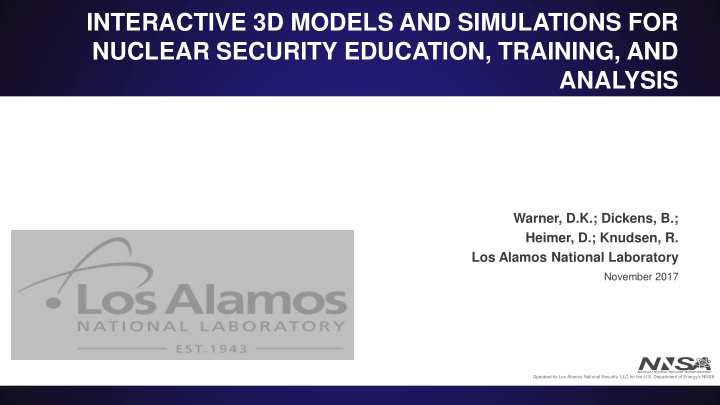



INTERACTIVE 3D MODELS AND SIMULATIONS FOR NUCLEAR SECURITY EDUCATION, TRAINING, AND ANALYSIS Warner, D.K.; Dickens, B.; Heimer, D.; Knudsen, R. Los Alamos National Laboratory November 2017 Operated by Los Alamos National Security, LLC for the U.S. Department of Energy's NNSA
Modeled Glovebox in Unity 3D Game Engine.
Injection of data and physics models examples • the ability to provide dynamic written postings that must be read for completing inspection operations • the ability to include random instances from within sets of physical layouts and information • breakout item data leading to a clean 2D graphical user interface(GUI) for informational data, specifications, and situational awareness information • radiation modeling (material attenuation) of radiation sources and detectors for real-time display
Injection of data and physics models examples (cont.) • realistic sound and environmental variables which are important in training and testing for harsh cognizant situations • decision trees in artificial intelligence (AI) interrogation • interactions with mock software on computer interfaces within the 3D experience • split screen bidirectional events from 2D GUI to the 3D model (library for quickly extending a written product manual to a complex 3D model of products)
Injection of data and physics models examples (cont.) • 3D instance Application Program Interface (API) for injected data i.e. data drives intensity of fire, amount of water in a basin, or advancement of troops/personnel • multi-player data • searchable databases of 3D objects and their associated and linked data • geometric spatial interactions i.e. characters attempting to enter a building requiring badge access or screening • the inclusion of haptic input allowing for hand and head control of movements within the 3D model.
Modeled Glovebox and RCT in Training Aid.
Example of Text and Object Breakouts in Models.
Examples of 3D Training Environment.
Instructor placed tags on assets of importance.
Insider Threat
Conclusion By providing examples of products that have been produced in the past, it is the hopes of the authors that the audience will have a more thorough understanding of 3D modeling tools, potential applications, and capabilities that they can provide. Truly the applications and capabilities of these types of tools are only limited by one’s imagination. The future of three -dimensional models lies in the expansion into the world of virtual reality where one will experience a fully immersive first-person environment. The use of headsets and hand tools will allow students and instructors to have a more thorough spatial understanding of facilities and scenarios that they will encounter in the real world.
Thank You! David K. Warner Los Alamos National Laboratory dkwarner@lanl.gov
Recommend
More recommend